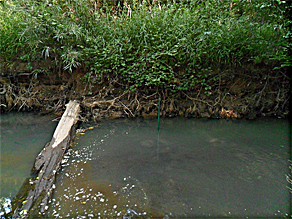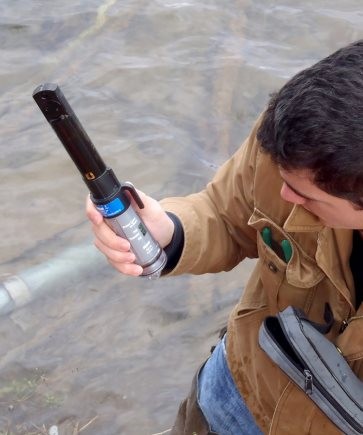- Home
- en
- datalogger-monitoring-systems
- hobo-applications
- water-quality-oxygen-levels-in-a-mussel-habitat
Data loggers record dissolved oxygen levels in the habitat of an endangered mussel species
North Georgia will soon have a new freshwater reservoir: Lake McIntosh. The planned 650-acre lake will be located on the border between Fayette County and neighboring Coweta County and will eventually provide more than 10 million gallons of drinking water per day. But first, the Fayette County Water System must assure the United States Fish and Wildlife Service that the endangered mussels that live in the affected creek will not be harmed.
That's where Chris Crow and his team at CCR Environmental come in. The Atlanta-based group of biologists conducts natural resource studies, endangered species surveys, environmental impact assessments and many other regulation-related studies for their clients.

Dissolved oxygen as an indicator of water quality
For this project, they are conducting physical and biological analyses of Line Creek downstream of the proposed reservoir. In addition to the usual instruments and techniques for data collection, including some underwater temperature data loggers, they are using a HOBO U26 dissolved oxygen data logger.
The amount of dissolved oxygen in a body of water is an indicator of its health; high dissolved oxygen levels correlate with high biological productivity, while low dissolved oxygen levels mean lower biological productivity. Since all animals, including mussels, require oxygen for respiration, dissolved oxygen is an important indicator of the relative health of an aquatic animal's environment.
Under the Endangered Species Act, the USFWS must be consulted on any project that may affect federally protected species or their critical habitat. The Lake McIntosh project was determined to potentially impact several federally protected mussel species, including the oval mussel (Pleurobema pyriforme), shiny pocketbook (Hamiota subangulata), and Gulf mussel (Medionidus penicillatus).

Advantages of using the HOBO logger
Previously, Crow and his team had measured dissolved oxygen in the field using hand probes. "We had the option of doing this manually," Crow explained, "which meant we had to be on site once a week before sunrise with a meter." It is common practice to measure dissolved oxygen just before dawn, when levels are at their lowest.
The HOBO dissolved oxygen logger is self-contained and can be deployed in a body of water (fresh or salt water) for weeks at a time to take measurements. The data is time-stamped and can be downloaded to a laptop or data shuttle. The supplied software enables the configuration and start as well as the display and analysis of the data. The logger offers an accuracy of 0.2 mg/L, maintains calibration for six months and has an easy-to-replace sensor cap.
The logger is also easy to position. "It's important to place the logger in the deep part of the creek in a well-mixed area," Crow explains, "with the sensor low enough down so it doesn't expose the probe when the water level drops." He deployed the device in Line Creek using a six-foot-high metal fence post. The logger was attached to the post with cable ties and fit vertically into the U-shaped groove of the post.
"The project started in early May 2012. The first few times we were on site, we did the dissolved oxygen measurements manually, and then we got the HOBO logger. We deployed it, checked it in the field a week later to make sure it was working, and then downloaded the data again at four to five week intervals. The team also confirmed the logger's measurements with a calibrated portable dissolved oxygen probe."

Crow likes how easily he can retrieve data from the logger. When he and his team visit the site now, they bring the optical base station with them, plug it into a laptop's USB port, "download the data, reset it and off they go," he says.
As expected, the lowest dissolved oxygen levels were measured at the height of summer. This is when the stream flow is lowest and the temperature is highest (cold water contains more dissolved gases than warm water - think cold or warm lemonade). "We can now see the highs and lows and also the diurnal cycle [day/night cycle]" to confirm that just before dawn is indeed the time with the lowest dissolved oxygen. "It's reassuring to know it's there," he said.
The data will provide dissolved oxygen information needed by the Fish and Wildlife Service and help determine how reduced flow affects dissolved oxygen - and therefore organisms in the river. The data will also serve as baseline data for a habitat comparison following construction of McIntosh Dam. The USFWS requires long-term dissolved oxygen monitoring associated with the dam's flow release, and this monitoring is being conducted by CCR for the Fayette County Water System.
Other dissolved oxygen loggers that Crow and his group considered cost several thousand dollars or were part of a much larger hydrolaboratory that was not necessary. The HOBO logger with graphing and analysis software costs less than $1,500.
Will they rely on this dissolved oxygen data logger for future projects? Now that Crow is confident in the device's performance, the answer is yes.
"It's all about the cost. It's more cost effective if you can set up a data logger, and you save money and time if you don't have to travel to the site as often."
Translated with www.DeepL.com/Translator


